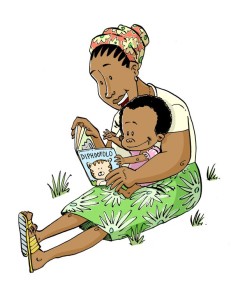 Although it is always wonderful to curl up on your own with a book, talking about what you are reading can be a different kind of “wonderful”! This could simply involve recommending a book you enjoyed reading to someone else, or chatting to a friend about the characters and the plot in a novel that you are both reading. We can have these kinds of conversations with our children too, but reading aloud to them, gives us opportunities to talk about books in other ways too.
Although it is always wonderful to curl up on your own with a book, talking about what you are reading can be a different kind of “wonderful”! This could simply involve recommending a book you enjoyed reading to someone else, or chatting to a friend about the characters and the plot in a novel that you are both reading. We can have these kinds of conversations with our children too, but reading aloud to them, gives us opportunities to talk about books in other ways too.
In fact, talking to children about a book as you share it together is just as important as reading the words to them! Through discussing the pictures, characters and what is happening in the story, children learn about how books work and how to explore them. Listening to, acknowledging and responding to what children say gives you both an interesting time. It also helps grow their language, confidence and self-esteem.
There is no “correct” time to talk to children about a book. (You can talk about a book before you start to read it, as well as while you are reading and then again afterwards – of course, what you talk about will change depending on how far into the book you are.) The best thing is to just let the conversation flow naturally as you enjoy a book together. Here are some ideas for helping the conversation along. You probably won’t use all of them each time, but select ones that fit best with the book you are reading. And, remember that the idea is to explore the book together rather than “test” your child’s understanding of what you have read together.
* Modelling. Demonstrate how we use and talk about books. For example, spend time talking about the information, illustration or photograph on the front cover of the book. Say, “Would you like me to read this book to you? I wonder what this book is about… shall we turn the pages and find out?” and “Do you like the picture on the cover?” Then draw your children’s attention to the title of the book, its author and illustrator. With older children, read the blurb on the back cover. Ask your children to use all of this information to guess what the book is about. When you do these things, children learn that they can use these book elements to help them choose a book for themselves.
* Sharing opinions and ideas. At different points in the story or afterwards, say what you think and ask your children what they think too. This helps children learn how to approach books.
* Learning to predict. Being able to guess what comes next as you read, is a skill that competent readers use all the time. As you read a story with your children, develop their prediction skills by asking, “What do you think will happen next?” at different points in the story.
* Paying attention to detail. Encourage children to look carefully and enjoy the illustrations in picture books. Draw their attention to different parts of the illustration on a page, comment on it yourself and ask them too. Ask younger children to find particular people or objects in the pictures. You can do this with words too. For example, draw their attention to the size of a large or small word on the page, or the interesting sound a word makes as you say it. With older children, talk about why the author might have chosen a particular word.
* Responding to questions. Young children often ask “Why?” You can either answer their questions by sharing your ideas (“I think it is because…”), or you can ask, “Why do you think…?”
* Connecting with stories. Many stories focus on how characters deal with challenges that life sends their way. It is powerful for children to relate these things to their own lives. Encourage them to make strong connections by saying something like, “This story reminds me of how important it is to treat people well. What does it remind you of?”
* Developing empathy. Children’s ability to empathise deepens when they put themselves in a character’s situation. Help them to do this by asking them to think about why characters behaved in particular ways in the story.

